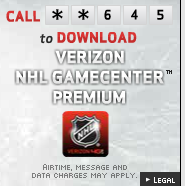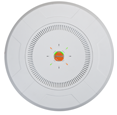 If you have a Verizon Wireless phone and are a hockey fan, good news today — Verizon extended its deal with the NHL and NBC Sports to add live streaming capabilities to its NHL GameCenter Premium app, presumably meaning that you might be able to watch those fisticuffs in real time on your handset.
If you have a Verizon Wireless phone and are a hockey fan, good news today — Verizon extended its deal with the NHL and NBC Sports to add live streaming capabilities to its NHL GameCenter Premium app, presumably meaning that you might be able to watch those fisticuffs in real time on your handset.
CORRECTION: Thanks to a friendly note from the folks at the NHL, hockey fans are not tied to one provider for the NHL’s GameCenter Live app, which provides live out-of-market coverage (for $79 for the rest of this season) to a number of different platforms, including Andriod phones, iPhones and iPads. The new Verizon deal with the NHL provides “bonus” coverage not offered in the regular GameCenter program. But fans with other carriers’ devices can still watch live NHL video. We apologize for the reporting error, and have edited the original post to eliminate confusion.
Even though fans can still watch NHL games live using any provider’s device, my greater worry is whether these deals in general are at all good for fans, or if they are short-sighted pacts made by leagues and broadcasters who are choosing some easy-picking rights fees over what’s best for their fan base at large. Though the NHL deal sounds more like a bonus for a Verizon subscriber, other pacts like Verizon’s NFL Mobile deal and Sprint’s NBA pact seem to put the deal before the concern of the fan.
Is that a good long-term strategy for any league? I mean, I understand all about rights deals — and why you have to switch from Fox to ABC to ESPN to NBC to watch different events at different times. But usually you can watch all those on the same TV. On a mobile device it’s different because for most of us the device is tied to the network via a subsidized contract. And few of us can afford another cell phone plan just to watch a certain sport.
The NHL, perhaps, should be praised for moving to a “carrier agnostic” plan this year for its GameCenter app. Let’s hope that practice catches on with other sports. Maybe the deals could simply result in a price discount for customers of a certain carrier; but exclusion of content by contract seems a slippery slope.









